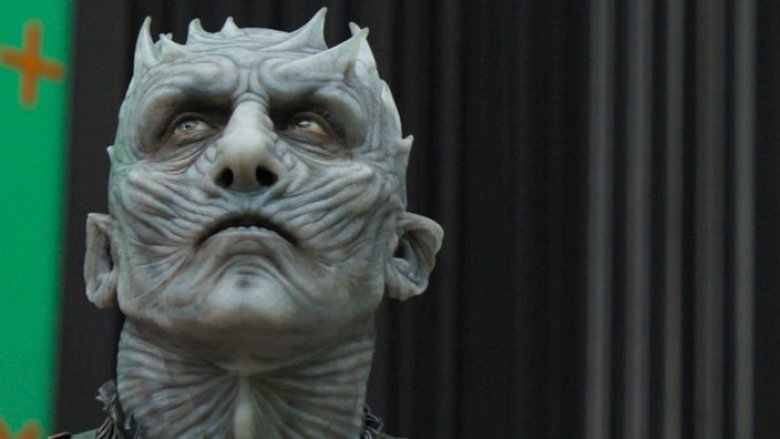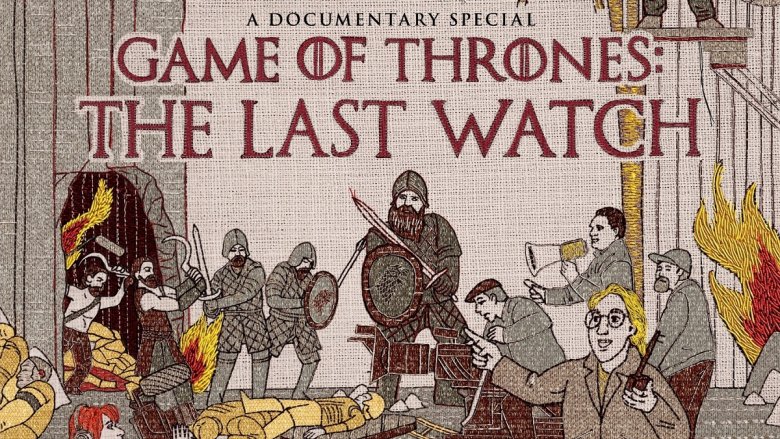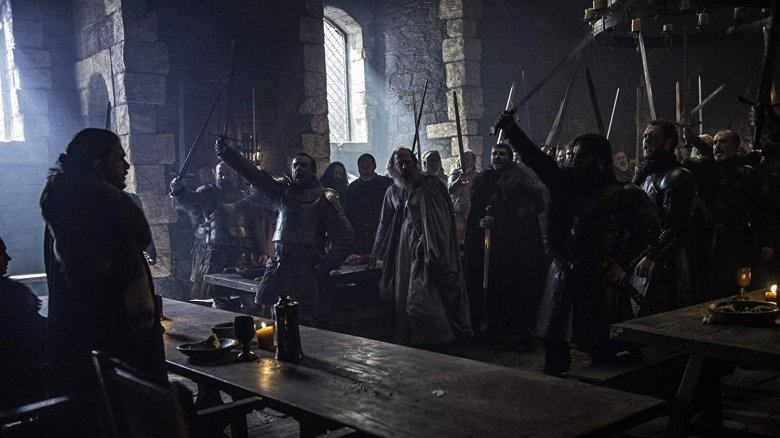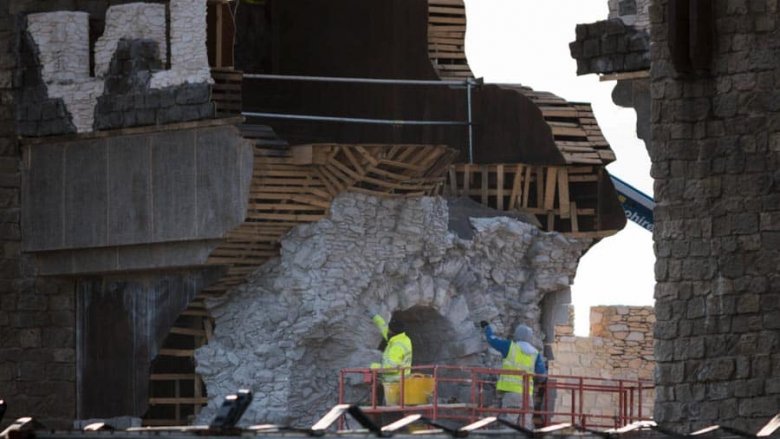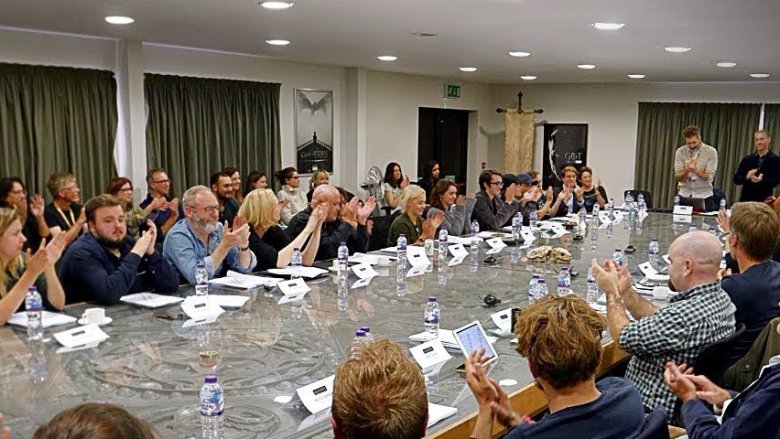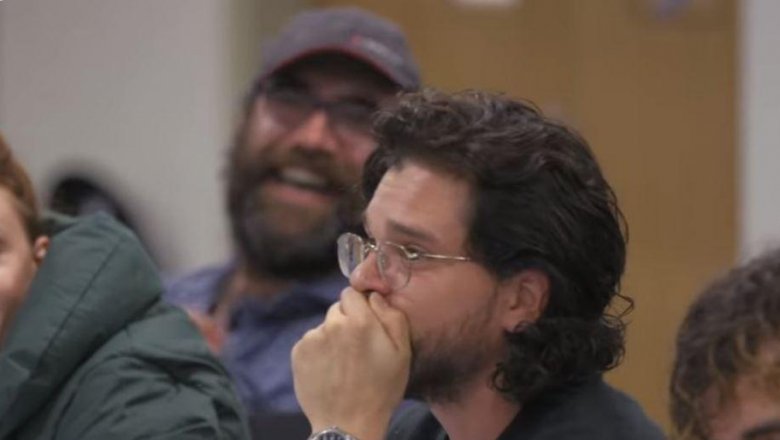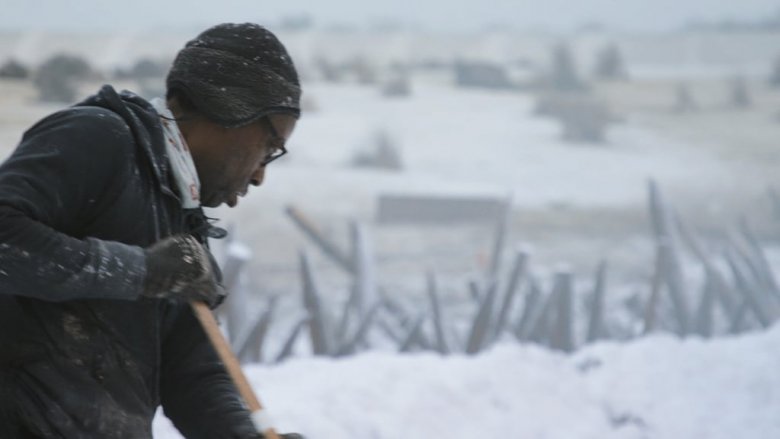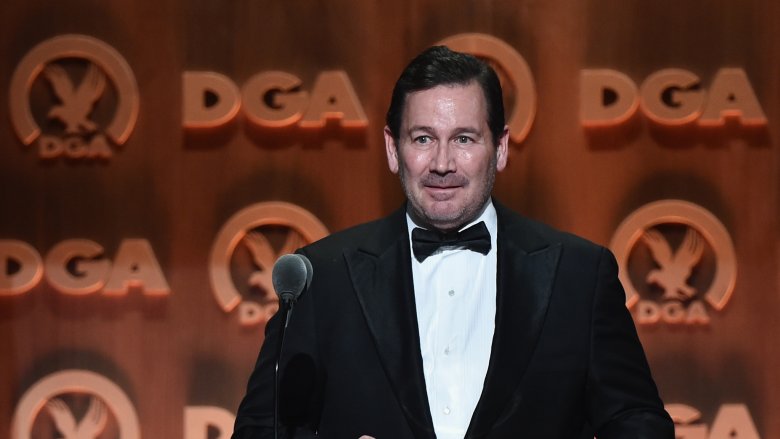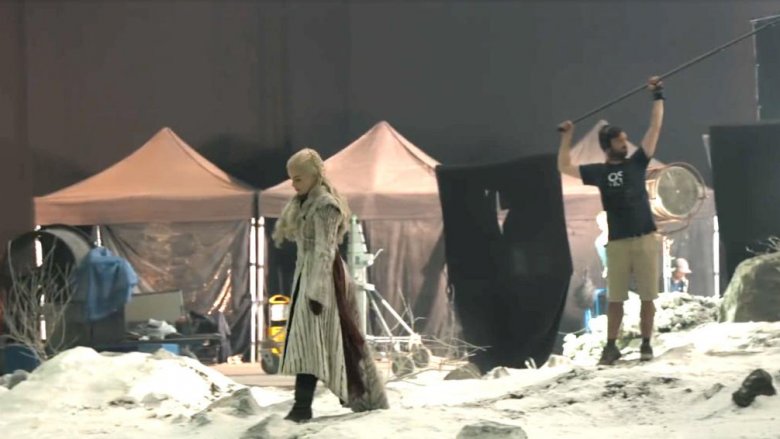Small Details Only True Fans Noticed In Game Of Thrones: The Last Watch
The final episode of Game of Thrones aired on May 19, 2019, but that didn't mean fans of this sprawling, epic series were ready for it to end just yet. Fortunately, HBO had them covered with a two-hour documentary just one week later, chronicling the impossibly large scope of the production for the shortened yet incredibly ambitious eighth and final season of Thrones.
Shrouded in secrecy, the ending of Game of Thrones was one of the most highly anticipated entertainment events of the past decade, and as such, the cast and crew behind this massive project put absolutely everything they had into its climax. No detail was overlooked and no expense spared. Even though the storylines of the final season received mixed reviews at best, nobody can fault the incredible production value. From the extraordinary shooting schedule of "The Long Night" to impromptu scouting trips in Iceland and Croatia to rebuilding foreign cities in Irish parking lots, here are the most important details revealed in Game of Thrones: The Last Watch.
A creative introduction
Game of Thrones created so many unforgettable moments during its eight-season run that no inside look at the finale would be complete without a trip down Westeros memory lane. In the first moments of The Last Watch, fans are treated to a gorgeous and detailed review of some of the series' most pivotal moments. Rather than these scenes simply being re-aired, though, they're stitched into a detailed tapestry.
From Ned Stark's execution to the Red Wedding to Stannis' end on the battlefield to the Night King wielding his brand new ice dragon, the camera pans over scene after scene of incredibly detailed embroidery depicting the show's most memorable images. For the title shot, it has one last surprise up its sleeve. Rather than feature any of the instantly iconic scenes from the closing episodes, this embroidery features crew members and directors overseeing shooting for the final season, paying homage to the armies of people who worked tirelessly behind the scenes to make sure that Thrones ran smoothly, looked incredible, and left behind an amazing legacy.
Extras returned over and over again
Throughout Thrones' years of filming, many people were lucky enough to be extras on set in far-flung locations from Dubrovnik, Croatia, to Belfast, Northern Ireland. Some of those extras, recognizing just how fortunate they were to be a part of one of the biggest productions in history, returned year after year. One man, Andrew McClay, spent the entire show as an unnamed Stark guard, returning to the same people in the costume department to get fitted for his Stark furs and armor each year.
A die-hard Thrones fan, McClay loves George R.R. Martin's world and has been reading the book series since he was just 13 years old. In the documentary, he argues passionately that the Stark house is the best house to be a part of, from the direwolves to the beauty of Winterfell to its cool armor. He also provides fans with one particularly neat bit of trivia — every season, crew and extras received new jackets once production wrapped with their "house" stitched on the sleeve, specifics on which unit they were a part of (for example, McClay's latest jacket reads "Dragon Unit, Belfast"), and a new design on the back for each season.
Another fun detail: at one point, Kit Harington's final jacket is visible, and his sleeve reads "The King in the North."
They built King's Landing from the ground up in Belfast
One of the most anticipated events in the entire series was Daenerys' eventual arrival at King's Landing to officially wage war, but considering that the city was likely to sustain a fair amount of damage, there was one big problem. For years, Dubrovnik, which sits right on the coast of Croatia and is known as the "Jewel of the Adriatic," has served as a picture-perfect stand-in for the capital of Westeros. Of course, this UNESCO World Heritage Site likely wouldn't take kindly to the level of destruction required for the final siege.
To solve this particular issue, the crew and production designers put in a truly unprecedented amount of work by rebuilding entire streets of Dubrovnik from scratch in a parking lot behind Thrones' Belfast studio, a process which took the better part of seven months. An interruption slowed the process considerably during Belfast's winter — thanks to a snowstorm that brought a record-setting amount of snow, construction was forced to pause. Once they had their near-perfect replica of Dubrovnik and thousands of extras loaded into the space, everything seemed perfect... until a Ferris wheel was erected right next to the set, jeopardizing its secrecy.
The script directions were incredibly specific
In a show as detailed as Thrones, it's unsurprising that no part of the set or script is overlooked (the occasional coffee cup or water bottle notwithstanding). That becomes apparent during the documentary footage of the series' final table reads, during which the actors listen, captivated, while the script's stage directions are read in full.
Unsurprisingly — especially for a show with so many quiet moments — a lot needs to be said in the stage directions, and the writers left nothing to chance. Big character deaths — a staple of Thrones throughout the entire series — seem to get the most specific direction, invoking earlier moments from the show or dictating other characters' reactions. For Jorah Mormont's (Iain Glen) death scene, in which he defends his Khaleesi to the very last moment, the stage directions specifically mention how many times he's stabbed by wights, even saying he's taken more damage than poor Hodor did back in season six. When Varys is torched by Daenerys' dragons as punishment for betraying her, the script notes how everybody feels about it — Tyrion is heartbroken, Jon is disturbed, and Grey Worm believes justice has been served.
The scripts made the cast emotional
For the cast, most of whom spent the entire run of Thrones inhabiting these now-beloved characters, the final table reads were always going to be highly emotional. The actors were as eager as the most rabid fans to learn who would live, who would die, and who would take the Iron Throne (if anyone). Now that the series has ended, fans can get an insight into those final table reads and see just how the performers behind the characters reacted to their own storylines.
Cast members were allowed to read all of the final scripts, but one actor notably saved the experience for the table read — Kit Harington, who plays Jon Snow, wanted to save his reactions so they'd be as authentic as possible. The documentary sees Harington discover that Jon Snow is slated to kill his lover (and aunt), Daenerys Targaryen (Emilia Clarke). He visibly breaks down, bursting into tears during the table read. Clarke, who has already read the script, nods grimly at him from across the table.
When it's revealed that Arya would kill the Night King, the entire table bursts into raucous cheers. Some moments, however, aren't as well-received — when Conleth Hill gets to the part where his character, Varys, is executed by Daenerys, he can be seen pushing his script away in frustration (reportedly, he was upset about some of the later seasons to begin with).
There was a Head of Snow
Considering that one of the most repeated lines throughout all of Game of Thrones was the phrase "winter is coming," there needed to be plenty of fake snow blanketing the set for the final season (particularly Winterfell, which, based in the usually rainy city of Belfast, needed some precipitation assistance). To that end, it's no surprise that one of the jobs on set had a very seasonally specific title.
The Last Watch introduces fans to Del Reid, who held the distinction of being the show's Head of Snow. It was his job to make sure the set's fake snowfall was consistent and at the ready throughout the series' entire production. Using paper and water, he mimicked real snowfall quite handily, dusting it over the ramparts of Winterfell and beyond to create an amazing dupe for actual frost. However, when an enormous snowstorm unexpectedly hit Belfast, his plans ended up fairly derailed. Still, the documentary finds him claiming that he would "welcome" natural snow.
David Nutter's precision
Longtime Thrones director David Nutter, whose first directing credit on the show was the second season's "The Old Gods and the New," went through an enormous journey of his own during the series. A frequent guest in the director's chair, Nutter helmed landmark episodes like "The Rains of Castamere" (which featured the infamous Red Wedding) and "Mother's Mercy" (in which Jon Snow is killed), with the latter earning him an Emmy. After suffering a serious injury following season 5, though, he didn't return to the Thrones set until the final season. He became the season's most prolific director, overseeing the first, second, and fourth episodes.
The documentary gives loyal fans an even deeper insight into Nutter's extremely precise process. Clearly an extremely visual director, Nutter draws floor plans for each scene he directs, noting where each character moves, and all of his plans are carefully drawn by hand in a method that he taught himself. He was also one of the only people to insist on printed scripts rather than scripts on an iPad for the secretive final season, making it clear that the rest of the crew had a deep respect for his process.
The ending was extremely emotional
After working on such a monumental series for so many years, it's natural that everyone involved would have intense reactions to the series' big finish. Even though the shoots for the final season were incredibly grueling, the documentary shows emotions running high for everyone from the lead actors to the wig handlers during the last days of production.
One location scout is seen paying one last visit to Castle Black, fondly remembering the spot where Jon Snow was stabbed and thanking the "old girl" for her service. The prosthetics department, meanwhile, can be found getting drinks, shedding tears, and sharing toasts to the end of the show. The documentary also captures an intimate look at Emilia Clarke's final scene as Daenerys, during which even the woman affixing Clarke's wig is seen wiping away tears.
The final scene ever shot was a scene from the finale in which Jon Snow confronts Grey Worm (Jacob Anderson) over the murder of Lannister soldiers. The Last Watch captures the final wrap being called on Game of Thrones, leaving everyone from co-creator D.B. Weiss to Kit Harington to the extras and crew visibly weepy. Andrew McClay, the eternal Stark extra who was called in for the scene, is seen sobbing in its aftermath, incredibly grateful for the opportunity but indescribably sad at its ending. With such a huge assembly of cast and crew, it must have been almost impossible to make sure that every goodbye was said in the best possible way.
